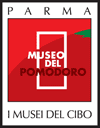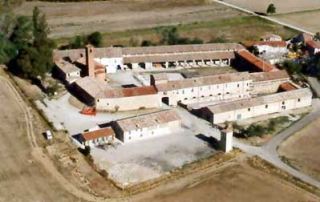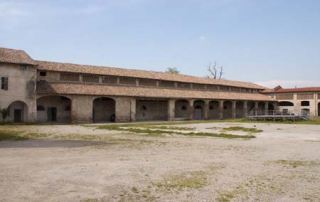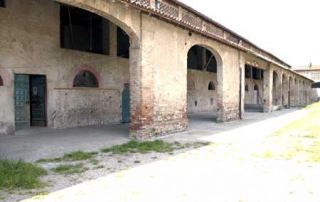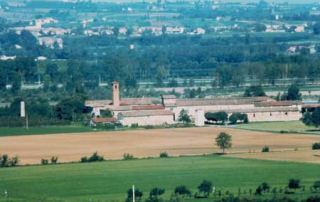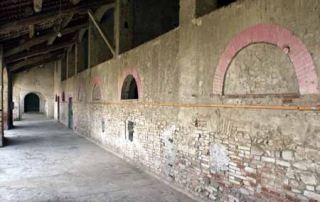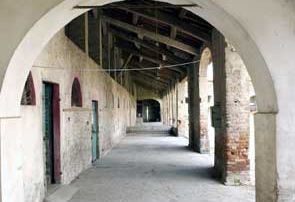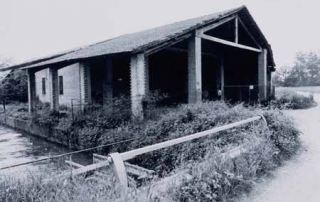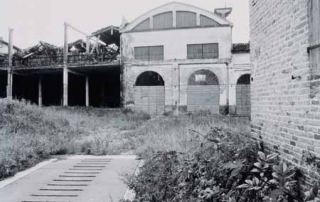Brief history of the Corte of Giarola, its cheese plant and its preserves factory
Giarola is on the right hand bank of the Taro river about half way between Fornovo and Pontetaro. The origins of the name can be quite easily guessed at, as the word Giarola means the small pebbles or gravel which formed the river bed.
In either Roman times or the High Middle Ages. At the head of one of the many crossing points over the river, Giarola was on the ‘pedemontana’ or foothills road which from the valley of the Baganza river and Talignano led to Medesano, Noceto and Borgo San Donnino (today’s Fidenza). The locality, entirely in the plain, was between Oppiano to the south, the main road to the east, the river Scodogno to the north and the Taro river to the west. Around the XI century which is when we first have information about the settlement it became the property of the Convent of St. Paul in Parma and seat of a small monastic community where there was a Church, stables and cow byres, dwellings, a watermill and a cheese factory; in short, a rural ‘court’ which was auto-sufficient and protected by such strong walls that in certain documents it is referred to as a castle or castro. The watermill was powered by the waters of the Taro Naviglio canal which then, as now, had its incline slightly upstream first at Ozzano and then more towards the valley, towards the Church at Oppiano where there was another monastic settlement, this time belonging to the Benedictines of St. John the Evangelist in Parma, and, with a watermill and perhaps also a xenodoch or small hospice for pilgrims who were following the river to Fornovo in order to begin the Apennine tract of the Via Francigena or Romea Road traced by pilgrims over the centuries. The Taro Naviglio canal thus ran through Collecchiello and Vicofertile and carried water to Parma to the Gate of St Francis, today Bixio, and finished up in the lake in the Ducal Park. The waters of the canal powered a number of watermills and ‘factories’ in the countryside and in the city including the Ducal factory of glass and majolica which passed to the Bormioli family half way through the XIX century.
So we can say that this whole area along the river bank once certainly marshy and full of thick woods, by the end of the first millennium had been rendered usable and productive land. The cultivations were wheat, forage, vines and rice. The paddy fields, already present in the XVI century, were suppressed by Ducal order but re-established in the XIX as they were economically viable. Thy were finally abolished in 1874 as damaging to the public health. The castle had its own limited strategic importance as it was hotly contested at the beginning of the XIV century by the factions united around the most important Parmesan families. It gave hospitality to Duke Francesco Sforza on his way from the Piacenza area to Parma and he left part of his army camped here under the command of Francesco II Gonzaga who dated some of his letters from Giarola on the eve of the Taro Battle on 6th July 1495.
Giarola was part of the system of establishing castles on the territory. Just to mention those which were near the ‘corte’ other castles or fortified courts were to be found at Madregolo, Collecchio,Segalara, Carona, and, beyond the river Taro, at Noceto, most of them in the hands of the Rossi family (1). The Church, instead, originally a simple chapel, though it was on the Via Francigena route, was not distinguished as a ‘pieve’ or parish church and depended on the church in Collecchio already in 1230. It certainly had the pleban shape with the triangular roof at the front, a semi-circular apse and small terracotta arches, some of which survived the restorations carried out over the centuries, in particular in the XVIII century, and the bombardments of the second World War. In the interior can be found, amongst others an Annunciation painted by a talented follower of Molosso, perhaps Francesco Lucchi (as suggested by Giuseppe Cirillo and Giovanni Godi) , from the XVII century in a later frame, a Holy Family with Saints Gioacchino and Anna of quite good quality from the second half of the XVIII century and an altar front of painted and worked leather from the same period (2).
(1)Lino Lionello Ghirrdini, the Battle of Fornovo: a historical dilemma, 2° edition, Edizioni Storiche d’Italia, Parma Tip. Bossoli, 1981,pp 27, 164
(2) Italo Dall’Aglio, The Diocese of Parma, Vol.1, Parma, Scuola Tipografica Benedettina, 1966 pp. 532-534


